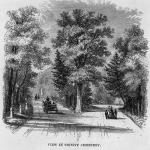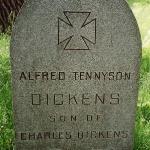This burial place [Audubon's], deeply shaded by original forest trees and varieties that have been planted, affords a most delightful retreat on a warm summer's day. It lies upon the slopes of the river bank. Foot-paths and carriage-roads wind through it in all directions, and pleasant glimpses of the Hudson may be caught through vistas at many points.
Benson J. Lossing
The Hudson
1866
Section 7, Block 2100
General statement of Early Title
This block, wholy within the farm of John Dyckman, passed to
Elizabeth Dunkin [Duncan] and Lydia Beekamn in 1816, and to the New York Bowery and Fire
Insurance Company in 1839. It was acquired by Richard F. Carman in 1841, and by the Rector,
Churchwardens, and Vestrymen of Trinity Church in the City of New York in 1842, for a cemetery.
References:
Farm Histories Volume page
Tract reports 460, 540
Map of tracts and farms Plate 40 R. D. 390
Deeds, Office of the City Register
66 John Street, 13th Floor,
New York, NY
Trinity Cemetery
By the early 1800s, cemeteries in lower Manhattan were filled almost to capacity. To alleviate the situation, in 1841, the Trinity Corporation purchased a large tract between 152nd Street and 155th Street for a new burial ground.
The first burial in Trinity Cemetery took place May 1, 1843, one year after the Audubon family moved to Minnies Land. When John James Audubon died in 1851, he was buried in a simple crypt in the southwest part of the cemetery, within sight of his house in Minnies Land. In 1892, in preparation for the building of the Riverside Drive extension, his body was reburied in the eastern part of the cemetery under a tall, elaborately-carved monument of bluestone that was quarried in the Catskills near Saugerties. Apparently, the city planned to extend Audubon Avenue south from its terminus at 165th Street and have it intersect 155th Street directly in front of Audubon’s monument, but that plan never materialized. Today, the grave with its elaborate marker is directly behind the Church of the Intercession, across Broadway.
From its creation, Trinity cemetery proved popular, not only as a final resting place, but also as a venue for riding and strolling. Manhattanites came uptown in their carriages and on foot, and after 1847, via the Hudson River Railroad, which had a station by the river at 152nd Street. After the Boulevard split the cemetery into its eastern and western halves around 1870, the Trinity Corporation contracted Vaux, Withers & Co to build a Gothic suspension bridge across Broadway just a few feet from the corner where you are standing. The bridge came down in 1911 to make way for the new Chapel of the Intercession (now, the Church of the Intercession), the third building to house its congregation. The first building, whose congregation included members of the Audubon family, was in Carmansville, at 154th Street and 10th Avenue (now Amsterdam Avenue). The second, built in 1872 and dedicated in 1873, was on the Boulevard at 158th Street, three blocks north of here; its spire rose 180, dominating the skyline above Audubon Park.
Before you leave this spot, you might be interested to learn that Alfred Tennyson Dickens, son of Charles Dickens and godson of the poet Alfred, Lord Tennyson, is buried on the hill just above where you are standing. In 1912, the centenary of his father’s birth, Dickens was making a lecture tour of the United States when he suddenly died of a heart attack in Manhattan. With the consent of his family, he was buried here in Trinity Cemetery under a simple stone marker.
 | ||||
 | ||||
 | ||||
Trinity Cemetery in the mid-1800s
(click to enlarge)
Audubon Monument in
Trinity Cemetery
Trinity Cemetery
(click to enlarge)
Alfred Tennyson Dickens Gravesite
(click to enlarge)
Continue your walk . . .
Funded by the Audubon Park Alliance


